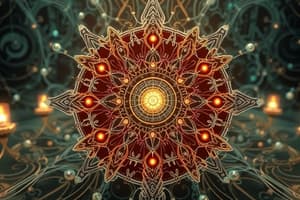Podcast
Questions and Answers
If the number density of atoms in the silicon specimen is known, how many acceptor atoms will there be per cubic centimetre?
If the number density of atoms in the silicon specimen is known, how many acceptor atoms will there be per cubic centimetre?
What happens to the probability of electrons being found in the conduction band of an intrinsic semiconductor at finite temperature?
What happens to the probability of electrons being found in the conduction band of an intrinsic semiconductor at finite temperature?
What is the typical ionization energy of a donor in silicon?
What is the typical ionization energy of a donor in silicon?
The reverse saturation current in a PN-junction diode is non-zero.
The reverse saturation current in a PN-junction diode is non-zero.
What will be the effect of applying a potential difference across an insulator, semiconductor, and metal?
What will be the effect of applying a potential difference across an insulator, semiconductor, and metal?
What is the forward voltage drop for a diode in a circuit?
What is the forward voltage drop for a diode in a circuit?
Calculate the maximum wavelength of light required to create a hole in a P-type semiconductor with acceptor levels 57 meV above the valence band.
Calculate the maximum wavelength of light required to create a hole in a P-type semiconductor with acceptor levels 57 meV above the valence band.
What is the current flowing through a plate of Ge crystal given the conditions?
What is the current flowing through a plate of Ge crystal given the conditions?
If Ge and Si diodes conduct at 0.3 V and 0.7 V respectively, what should happen if the Ge diode connections are reversed?
If Ge and Si diodes conduct at 0.3 V and 0.7 V respectively, what should happen if the Ge diode connections are reversed?
For a transistor amplifier in common-emitter configuration, what is required to determine the current gain?
For a transistor amplifier in common-emitter configuration, what is required to determine the current gain?
Flashcards are hidden until you start studying
Study Notes
Semiconductor and Electronics - JEE HOTS
Doping and Semiconductor Properties
- A silicon specimen can be made into a P-type semiconductor by doping, on average, one Indium atom per silicon atom.
- The number density of atoms in the silicon specimen determines the number of acceptor atoms in silicon per cubic centimeter.
Probability of Electrons in Conduction Band
- The probability of electrons to be found in the conduction band of an intrinsic semiconductor at a finite temperature:
- Decreases exponentially with increasing band gap
- Is not independent of the temperature and the band gap
Ionisation Energy of Donor in Silicon
- The typical ionisation energy of a donor in silicon is 0.05 eV.
PN-Junction Diode
- Reverse saturation current in a PN-junction diode is 10^-12 A at T = 300 K.
- Forward current for a voltage of 0.5 V is 10^-3 A.
Insulator, Semiconductor, and Metal
- Current passing through:
- An insulator at T = 0 K is zero
- A semiconductor at T = 0 K is zero
- A metal at T = 0 K is finite
- A P-N diode at T = 0 K is finite, if it is reverse biased
Diode Circuits
- Current supplied by the battery when its positive terminal is connected to A is 5 mA.
- If the forward voltage drop for the diode is 0.5 V, the current will be 10 mA.
Acceptor Levels and Hole Creation
- A P-type semiconductor has acceptor levels 57 meV above the valence band.
- The maximum wavelength of light required to create a hole is 2175 nm.
Transistor Amplifier
- Current gain in a transistor amplifier in common emitter configuration is 50.
- Output voltage of the amplifier will be 10 V.
Semiconductor Concentrations and Mobility
- Concentrations of electrons and holes in a semiconductor are 8 × 10^18/m^3 and 5 × 10^18/m^3 respectively.
- Mobilities of electrons and holes are 2.3 m^2/volt-sec and 0.01 m^2/volt-sec respectively.
Half-Wave Rectification
- RMS voltage across R in a half-wave rectification circuit is approximately 141.4 V.
Diode Characteristics
- Voltage across the diode is independent of current above the knee point (0.7 V).
- The minimum current required to be above the knee point is 1 mA.
Transistor Applications
- Voltage gain and power gain in a transistor amplifier in CB mode are 69.7 and 68.25 respectively.
Bohr Radius
- Bohr radius of the fifth electron of phosphorus acting as a dopant in silicon is 1.35 nm.
PN-Junction Diodes in Series
- The correct increasing order of resistance between A and B will be D1, D2, and D3.
Diode Circuits with Capacitors
- The voltage across the capacitor in a diode circuit with a capacitor is 220 V (rms) AC.
Semiconductor Current Flow
- Current flowing through a Ge plate with an applied voltage of 2 V is 2 mA.
Semiconductor Current Components
- Contribution to the total current flowing through a semiconductor due to electrons and holes are 2 mA and 1 mA respectively.
Diode Voltage Drops
- Ge and Si diodes conduct at 0.3 V and 0.7 V respectively.
- Reversing the Ge diode connection changes the value of V0 by 0.4 V.
Logic Gates
- The combination of gates shown produces a NOR gate.
- The system is equivalent to the following logic gate: NAND.
- The output F of the circuit is represented by F = A + BC.
- The diagram of a logic circuit produces an output F = AB + C.
Studying That Suits You
Use AI to generate personalized quizzes and flashcards to suit your learning preferences.




